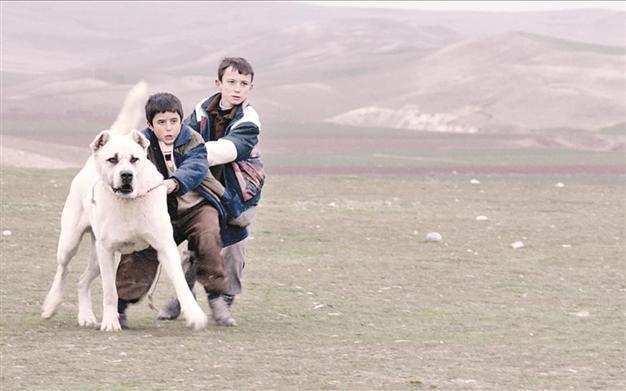Two paws up for dogs in Turkish cinema
Emrah Güler

Kaan Müjdeci’s debut feature 'Sivas' is set to premiere at the Venice International Film Festival on Sept. 3
Young director Kaan Müjdeci’s much-hyped debut feature “Sivas” is set to premiere at the Venice International Film Festival on Sept. 3, competing both for the Golden Lion and the Lion of the Future award given to best first film. Its stars are an unlikely pair for a newcomer: An 11-year-old boy and a dog. Set in the steppes of Central Anatolia, the film is a coming-of-age story in which the boy, named Aslan, rescues a wounded Anatolian shepherd in a ditch, after which he forges a friendship with his dog.Initially, Aslan makes use of the dog’s fighting skills for popularity and attention, especially from the little belle of the village. However, interest is not limited to the object of Aslan’s affection, and the tale of the fighting dog reaches the village head. Aslan’s journey into adulthood has been described by Müjdeci as being “about the continuously evolving life and character of a small boy and a small village.”
In another new release, “Azazil: Düğüm,” a dog shapes the story - if not becoming one of its leading actors. Director Özgür Bakar’s film is the latest in a genre that has become increasingly popular over the last two decades: The Islamic horror, in which ghosts and zombies become genies, exorcisms are performed by hodjas, and the apocalypse takes its form from the Quran. The paranormal storyline of Bakar’s latest kicks off after the leading couple accidentally hit a dog with their car and kill him.
Rhino and Max take screen time
Typically, dogs have never taken much screen time in Turkish cinema, save an odd one popping on screen thanks mostly to the director’s love of canines. In 2010, seasoned festival director and movie buff Ahmet Boyacıoğlu’s directorial debut “Siyah Beyaz” (Black and White) paid tribute to the dry but somehow inspirational capital city of Ankara through its oldest night haunts, giving the movie its name.
As the founding father of the prolific Ankara Cinema Association, Boyacıoğlu himself is a name associated with Ankara. With “Siyah Beyaz” being a tribute to the city, it was only fitting to have one of its most famous dogs sharing screen time with a cast that could also be described called a hall of fame. Rhino, one of the dogs of Tarkan Özvardar, the founder of the Ankara Canine College, was already a famous name in Ankara. Formerly a European Frisbee Champion, the Border Collie played the companion of Taner Birsel’s bar’s owner in the film.
 Perhaps the most famed canine actor in Turkish cinema is Max, the Border Collie that won the talent show “Yetenek Sizsiniz Türkiye” (Turkey’s Got Talent) two years ago, beating singers, dancers and jugglers to win the title. Soon after his TV success, Max was approached to star in the leading role in a movie, when director Murat Şeker’s 2013 “Arkadaşım Max” (My Friend Max) took the familiar theme of a boy’s friendship with a dog and presented it to Turkish audiences.
Perhaps the most famed canine actor in Turkish cinema is Max, the Border Collie that won the talent show “Yetenek Sizsiniz Türkiye” (Turkey’s Got Talent) two years ago, beating singers, dancers and jugglers to win the title. Soon after his TV success, Max was approached to star in the leading role in a movie, when director Murat Şeker’s 2013 “Arkadaşım Max” (My Friend Max) took the familiar theme of a boy’s friendship with a dog and presented it to Turkish audiences.Running away from his owner’s malicious nephew, Max become friends with the little boy Deniz, with whom he has adventures all-too-predictable for the followers of dogs in movies, tailored specifically to children. The film was a big box office success, especially among young audiences and those who had cheered Max earlier on TV.
Barking Island: Dogs from history
Although not by a Turkish filmmaker, Armenian director Serge Avedikian’s Palme d’Or-winning short “Chien d’Histoire” (Barking Island) of 2010 is about Turkey’s historically problematic relation with dogs. The animated short is based on events that took place in Istanbul in 1910, when over 30,000 stray dogs were deported to a remote island off the coast of the city.
The mostly bleak animation is made up of paintings rendered by a young artist, Thomas Azuélos, and tells the story of the deportation - which eventually led to the death of the 30,000 dogs from starvation, thirst and drowning - through the eyes of one of the dogs and the policeman who puts her in a cage.
In her 2008 book “Les chiens d’Istanbul” (The Dogs of Istanbul), French anthropologist Catherine Pinguet traced the deportation of dogs to the newly-founded Ottoman government’s quest for modernization and Westernization.
Similarly, Chris Pearson in his blog piece titled “Stray Dogs in Istanbul,” writes that “Alongside promoting constitutionalism, secularization, and nationalism, they wanted to rid Istanbul of stray dogs, which they saw as symbols of a disorderly and backward urban society.”
















